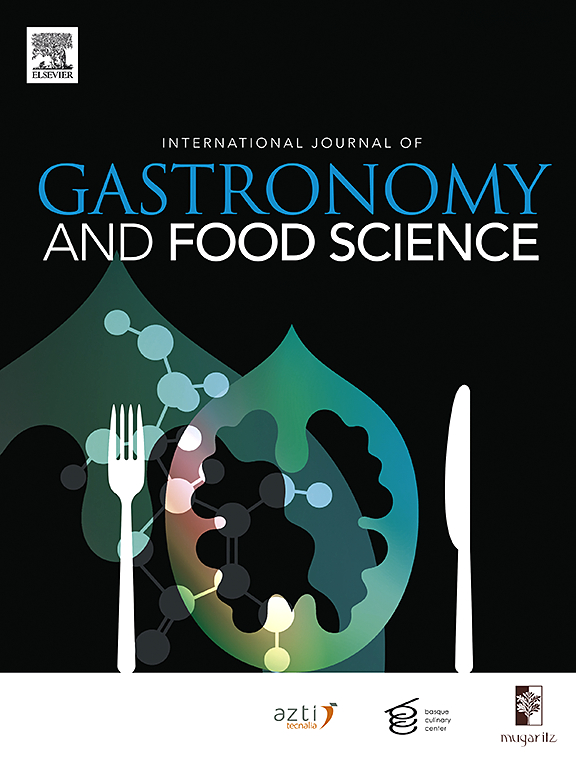“味道不错,但不是鸡肉”:瑞典人对植物性鸡肉的感官喜好驱动因素及其相关性
IF 3.6
2区 农林科学
Q2 FOOD SCIENCE & TECHNOLOGY
International Journal of Gastronomy and Food Science
Pub Date : 2025-06-19
DOI:10.1016/j.ijgfs.2025.101229
引用次数: 0
摘要
通过更好地了解喜恶的感官驱动因素,可以加快令人满意的植物性肉类类似物的开发。为了解决这个问题,这里对六种市售的PB鸡类似物和鸡胸肉进行了评估。消费者(N = 105)报告了享乐喜好(外观、香气、味道/味道、质地和整体),用“全部适用率”(RATA)和“恰到好处”(JAR)量表对样品进行感官描述,并用自己的话描述他们对尝过的样品的喜欢和不喜欢的地方(自由文本回答)。对样品也进行了仪器表征:显微镜观察微观结构,循环压缩测试量化关键力学性能(最大真应力、杨氏模量和压缩能)。运用主成分分析和刑罚分析对感官空间进行了探索;使用贝叶斯网络分析评估喜欢的方式和这些方式如何决定整体喜欢之间的联系;并使用贝叶斯推理的多元回归来对比样本之间的喜好,并确定每种享乐模式中(不)喜欢的驱动因素。鸡肉在所有的享乐方式中都是首选,而真菌蛋白制成的样品在大多数PB样品中都是喜欢的。除了外观之外,所有模式都检测到喜欢的驱动因素。纹理喜好的驱动因素包括更高的感知嫩度和多汁性,后者也与第一次压缩循环时的杨氏模量呈负相关。自由文本回复表明消费者很容易认出鸡肉样品。感官反应反映了产品的内在属性(自下而上)和认知(自上而下)方面,包括熟悉度,因此讨论。本文章由计算机程序翻译,如有差异,请以英文原文为准。

“It's not bad, but it's not chicken”: Sensorial drivers of liking and their correlates for plant-based chicken analogues in Sweden
Development of satisfying plant based (PB) meat analogues could be expedited through better understanding of the sensorial drivers of hedonic (dis)liking. To address this, here six commercially available PB chicken analogues and a chicken breast reference are evaluated. Consumers (N = 105) report hedonic liking (appearance, aroma, taste/flavour, texture, and overall), sensorially profile the samples with rate-all-that-apply (RATA) and just-about-right (JAR) scales and describe what they like and dislike about the tasted samples in their own words (free-text responses). The samples are also characterized instrumentally: microscopy to visualize the microstructure and cyclic compression testing to quantify key mechanical properties (maximum true stress, Young's modulus, and compressive energy). The sensory space is explored with principal component analysis and penalty analysis; associations between the modalities of liking and how these may determine overall liking is assessed using Bayesian network analysis; and multiple regression with Bayesian inference is used to contrast liking across samples and identify the drivers of (dis)liking within each hedonic modality. Chicken is preferred across all hedonic modalities, while samples made of mycoprotein are liked most of the PB samples. Drivers of liking are detected for all modalities except appearance. The drivers of texture liking include higher perceived tenderness and juiciness, the latter of which is also inversely correlated with Young's modulus on the first compression cycle. The free-text responses suggest that consumers readily recognized the chicken sample. That sensory responses reflect both the intrinsic properties of products (bottom-up) and cognitive (top-down) aspects, including familiarity, is thus discussed.
求助全文
通过发布文献求助,成功后即可免费获取论文全文。
去求助
来源期刊

International Journal of Gastronomy and Food Science
Social Sciences-Cultural Studies
CiteScore
5.30
自引率
10.50%
发文量
170
审稿时长
45 days
期刊介绍:
International Journal of Gastronomy and Food Science is a peer-reviewed journal that explicitly focuses on the interface of food science and gastronomy. Articles focusing only on food science will not be considered. This journal equally encourages both scientists and chefs to publish original scientific papers, review articles and original culinary works. We seek articles with clear evidence of this interaction. From a scientific perspective, this publication aims to become the home for research from the whole community of food science and gastronomy.
IJGFS explores all aspects related to the growing field of the interaction of gastronomy and food science, in areas such as food chemistry, food technology and culinary techniques, food microbiology, genetics, sensory science, neuroscience, psychology, culinary concepts, culinary trends, and gastronomic experience (all the elements that contribute to the appreciation and enjoyment of the meal. Also relevant is research on science-based educational programs in gastronomy, anthropology, gastronomic history and food sociology. All these areas of knowledge are crucial to gastronomy, as they contribute to a better understanding of this broad term and its practical implications for science and society.
 求助内容:
求助内容: 应助结果提醒方式:
应助结果提醒方式:


